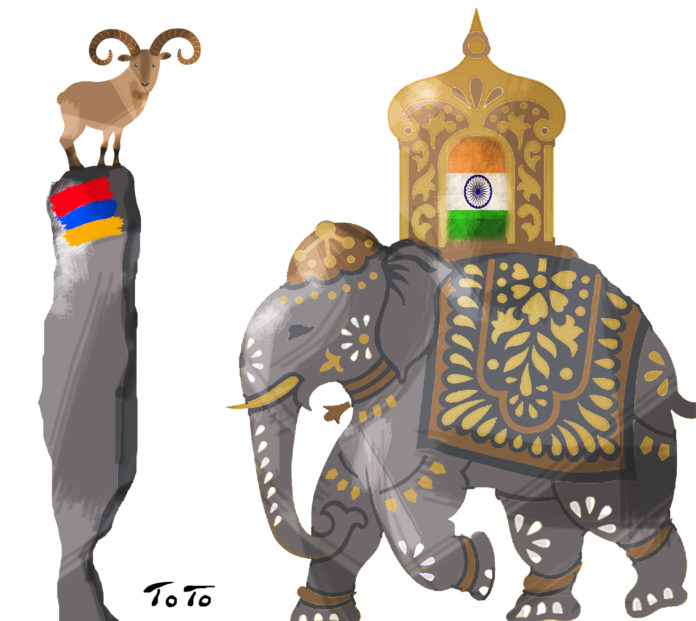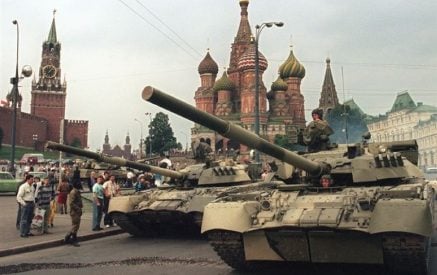by Edmond Y. Azadian
The adage that “my enemy’s enemy is my friend” does not always prove true. But in the case of India, it does. India and Pakistan have a longstanding dispute over the Jammu and Kashmir region. Both states are nuclear powers and the diplomatic world always watches with trepidation the escalation of rhetoric between the two nations.
One party in that equation, Pakistan, has thrown in its lot with Turkey and Azerbaijan, leading India to find its own way in the region and increasing ties with their target, Armenia.
Read also
Turkey and Pakistan are two nations sharing characteristic behaviors in promoting their interests. Both have weaponized Islam and both are actively exporting terrorism and using terrorists in proxy wars. Pakistan has been caught red-handed in the past using terrorists against India. It has also trained Taliban insurgents to destabilize Afghanistan, who shockingly overthrew the US-supported government in that country, while pretending to serve US interests in the region.
Turkey’s conduct has similar hallmarks; while officially serving as a NATO ally, it has used terrorists in all its wars in Syria, Libya, Somalia and elsewhere, most recently in Karabakh. Right now, it is threatening the Kurdish forces allied with the US in Syria.
For a long time, India maintained a balanced relationship with the countries in the Caucasus. However, that is no longer the case. The Pakistan air force’s involvement in Karabakh and its joint military exercises in Azerbaijan, along with Turkish and Azerbaijani forces, as a direct show of force against Iran, has alarmed policymakers in India to the point that they are now engaged in a more assertive way in the region.
Additionally, the odd alliance between Turkey, Pakistan and Israel coupled with Ankara’s drive toward Central Asia have warranted a response from India, whose foreign minister, Subrahmanyam Jaishankar, just completed a three-country tour, with Armenia the final stop.
In fact, Jaishankar is the first Indian foreign minister to visit Armenia since the two countries established diplomatic relations in 1992.
The other two countries he visited were Kyrgyzstan and Kazakhstan, which are in the sights of Turkey to become part of the new potential Turanic empire.
There are two significant points to note in Jaishankar’s visit. The first is that he avoided Azerbaijan, meaning that the latter is firmly in the enemy camp. The other point is that a small country like Armenia would ordinarily be treated to a much lower-level emissary than the foreign minister himself.
The discussions between Jaishankar and his Armenian counterpart, Ararat Mirzoyan, included game-changing relations in the region, particularly regarding trade routes and economic projects. But before outlining those projects, one must note also the political undertones developing there. In that regard, Russia has been promoting a 3+3 formula for the resolution of the outstanding issues between the parties in the region.
This negotiation formula was recently proposed by Russian Foreign Minister Sergey Lavrov to visiting Iranian Foreign Minister Hossein Amir-Abdollahian. The parties involved in this formula would be Armenia, Azerbaijan, Georgia, Iran, Russia and Turkey. The problem for Armenia is that none of those countries is interested in trying to resolve the issue of the status of Karabakh within the framework of the Organization for Security and Cooperation in Europe (OSCE) Minsk Group, except perhaps for Georgia, which is at odds with Russia.
It is in the interest of Russia and Turkey to keep the West away from the Caucasus and finalize the deal amongst themselves. Already, the New York Times reported on October 19 that Russia has ended its diplomatic mission to NATO. Fortunately, Georgian Foreign Minister David Zalkaliani had pronounced the formula dead on arrival.
Then, the recent flare-up between Iran and Azerbaijan (and Turkey, by association) has made the formula even less tenable.
On the other hand, India maintains the same principle as Armenia, that the Karabakh issue must be resolved within the framework of the OSCE.
Other favorable developments for Armenia are emerging from Iran. While the country’s supreme religious leader, Ali Khamanei, was congratulating the “brotherly” Azerbaijani people for having recovered their territory following the 44-day war in the immediate wake of the ending of the war, today other contradictory messages are emanating from Tehran, as Israel’s military presence on Azerbaijan’s soil is too close for comfort for the Iranian leadership.
For example, the head of the Islamic Revolutionary Guards Corps in Tabriz, in Iran’s Azerbaijan Province, Col. Hossein Pursmail, recently announced: “The repetition of Israel’s threats against Iran through the mouth of Azerbaijan is not only not conducive to Baku’s interests, it is also a threat to the latter’s very existence.”
On the other hand, Iranian lawmaker Mahmoud Begash has remarked that “If the Turkish adventure and Azerbaijan’s behavior continue, we will return Nakhichevan and Nagorno Karabakh to their rightful owner – Iran.”
In conjunction with its bellicose rhetoric, Iran held its largest-ever military exercises under the code name “Conquerors of Khaybar,” startling President Ilham Aliyev.
Jaishankar’s package also includes a military component, along with other economic infrastructure initiatives.
In view of Russia’s cavalier treatment of Armenia, underarming and pretending to defend Armenia’s territorial integrity, these statements from other capitals provide an alternative source of hope to Armenia’s destitute leadership. No one can expect that Iran or India will introduce their armed forces in Syunik to thwart an Azerbaijani attack, but their posturing will quite possibly deter Azerbaijan and Turkey from engaging in that kind of military conflict, knowing that Armenia has active, interested and powerful allies.
Armenian-Indian relations have been developing steadily since 2019, when Prime Minister Nikol Pashinyan and Indian leader Narendra Modi met in New York and discussed a host of issues of mutual interest. More recently, India’s foreign minister met with his counterpart in Dushanbe. Therefore, this historic visit to Armenia was the culmination of those earlier developments.
The Indian foreign minster was particularly appreciative of Armenia’s support for this country’s candidacy for the United Nations Security Council as both a permanent and non-permanent member.
Both sides extolled the historic relations between the two nations. Indeed, the first Armenian-language newspaper, Aztarar, was published in Madras, India, in 1794. At that time, the city enjoyed a vibrant Armenian community. In fact, Armenians established many trading posts on Silk Road, from the Indian subcontinent to Harbin, China to Sumatra, Java and all the way to Venice. The Indian-Armenian community, originally from Julfa, Iran, had developed an intellectual class eager to liberate Armenia or purchase from the Sultan a territory for a future Armenia.
By contrast, the Turkey-Azerbaijan-Pakistan nexus has created problems for most of the countries in the region. For example, Saudi Arabia, which claims to be the leader of the Sunni world, has shifted its investment policy away from fellow Islamist Pakistan ($1.7 billion in 2019) to India ($33 billion).
Armenia and India are members of the International North-South Transport Corridor (INSTC). Because of belligerence from the Azerbaijan-Turkey-Pakistan triad, India and Iran have decided that the INTSC will begin to run through Armenia, rather than Azerbaijan, which had invested massive resources in this network project. This will mean an economic boost for Armenia and a major setback for Azerbaijan.
In the past, Turkey and Azerbaijan used to place all the oil pipeline and railway lines in such a way as to bypass Armenia, with approval from Georgia, in the hope of further impacting Armenia’s depressed economy. With India’s involvement and the standoff between Iran and Azerbaijan, the equation is changing in Armenia’s favor.
During the discussions with the Armenian side, Foreign Minister Mirzoyan expressed his interest in using Chabahar port in Iran, which is being developed by India. These alternatives provide some room to maneuver for Armenia, as negotiations are waiting to begin with Turkey and Azerbaijan for the creation of routes throughout the Caucasus almost one year after the cessation of hostilities of the devastating Second Karabakh War.
In the best case scenario, Turkey and Azerbaijan will decide to allow trade traffic through their territories as Armenians will remain hostages to the whims of their enemies.
Russia would not look favorably at these developments, particularly India’s partnership with Iran and Armenia, because it indicates a loss of control when it was convinced that Moscow and Ankara could shape the economic infrastructure of the region.
In addition to the economic issues, international political factors are also against the Russia-Turkey-Azerbaijan tandem, because all efforts to block OSCE’s participation in solving the Karabakh issues are failing hopelessly.
These new developments may help Armenia only in case its leadership realizes the value of the opportunities and take advantage of the situation.


























































